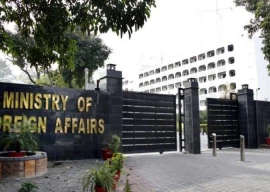
It took farmer Ghulam Hussain almost a year to start re-building his house, destroyed last year in floods that left vast swathes of the country underwater, and disrupted the lives of more than 18 million people.
Now, his small, two-room mud and brick house - just a few hundred metres from the Indus River - is almost complete, but he is worried as to how long it will survive.
“It took me a long time to rebuild my house, as no one gave me any help,” Hussain said, as he along with five of his relatives put the final touches to his house in Sindh.
“I am praying to God that this year the waters be kind to us,” he said.
Pakistan remains woefully unprepared for floods this year which a UN official said could affect up to five million people in a worst-case scenario.
All along the Indus, dykes and embankments are incomplete, while international donations for preparedness have fallen short. Sindh, one of last year’s most hard-hit provinces, is especially vulnerable to new flooding.
A visit in rural Sindh revealed that most preparations the government says are complete still need weeks of work - and the rains have already started. “I don’t think the government has done enough,” Hussain said. “It is only up to God to save us.”
As he spoke, he glanced at the Tori Bund, just a few hundred metres away in one of the worst-hit areas of last year’s floods. It was a poor defence against the rage of the swollen Indus River last year.
Last year’s floods began in late July after heavier-than-usual monsoon rains swelled the headwaters of the Indus River basin, sending flash floods through the northwest and inundating great swaths of the country.
Around 2,000 people died, 11 million left homeless and another seven million people were affected. The country suffered more than $10 billion in damages to infrastructure, irrigation systems, bridges, houses and roads. One-fifth of Pakistan was submerged. Aid organisations and the government were criticised for being too slow to respond while the military, believed to be a far more efficient institution, took the lead in relief operations.The United Nations say it is working hard to stockpile food, water and tents in the event of more floods this year.
“Since the beginning of March, we have been in close contact with the government to make sure response is up and running and that we are better prepared this year,” Manuel Bessler, head of the UN emergencies office (OCHA) in Pakistan, said in a recent interview with AlertNet, a free humanitarian news service run by Thomson Reuters Foundation.
He said the most likely scenario is two million people affected, but it could reach five million if the monsoons are heavier than expected. The seasonal rains - expected to start July 1 - started four days early.
At the Tori Bund near Hussain’s house, labourers slowly stacked stones and mud in an attempt to strengthen the embankment, where two major breaches last year swept away hundreds of houses and flooded acres of land. “I can tell you that 80 per cent to 95 per cent work has been completed at most of the places and by June 30, all will be completed,” said Pir Buksh Jamali, the director-general for the Sindh Provincial Disaster Management Authority.
This correspondent visited the areas Jamali said were ready but found out that much work remains to be done. At Tori Bund, huge piles of unused mud and heavy stones remained, and workers there seemed to be in no rush.
“We started working here in late February and will do our best to complete work in the next 15 to 20 days, before water reaches here,” said consultant Maqsood Ahmad, overseeing the reinforcement work at the embankment. “But I think the work here should have started at least two months earlier.” He added that he was not sure if the reinforced dyke would be strong enough to hold heavy flooding.
About 20 kilometres away from Tori, work at the KK bund started only a week ago. Other sites were at a similar state. According to government officials, some 147 sensitive points were identified by the irrigation department across the province, but due to lack of funds and proper planning, work at about 75 of them has yet to be completed.
Unpredictable floods
The Pakistan Meteorological Department expects this year’s monsoons to be 10 per cent below normal. However, rains in Pakistan’s northern areas and Kashmir - which drain into the Indus River basin - are expected to be 10 per cent higher than last year. Environmental conditions such as increased snow melt in mountainous areas was leading to high water levels in rivers, while groundwater levels were already high after last year’s deluge, reducing its absorption capacity. And while Pakistan and the United Nations say they’re ready for two million flood-affected “if the flood levels are anywhere close to last year that would mean trouble,” said Buksh Jamali.
The UN last year appealed to the world for almost $2 billion to help survivors - the biggest appeal ever launched by the body for any humanitarian emergency. Yet, 30 per cent of the appeal remains unfunded almost one year on.
“It’s much easier to find money for the coffin than for the medicine,” OCHA’s Bessler said ruefully.
Published in The Express Tribune, June 30th, 2011.























COMMENTS
Comments are moderated and generally will be posted if they are on-topic and not abusive.
For more information, please see our Comments FAQ